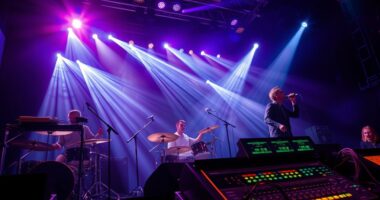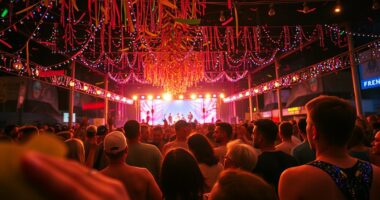To create an effective storyboard for live-event music videos, focus on breaking down the song into key moments and visualizing each segment clearly. Plan shot types, camera movements, lighting, and staging to capture energy and mood. Use sketches or thumbnails to communicate your ideas with your team, and review the plan to guarantee flexibility and smooth execution. Mastering these basics sets a strong foundation for a dynamic performance — continue to explore how to refine each detail.
Key Takeaways
- Break down the song into key moments and sketch scenes to plan visual storytelling effectively.
- Use rough sketches or thumbnails to visualize shot types, angles, camera movements, and transitions.
- Incorporate atmosphere elements like lighting, staging, and environment to match the mood of the live event.
- Include instructions for camera operators and performers to ensure clarity during filming.
- Review and adjust the storyboard with the team to maintain flexibility and improve overall flow.

Creating a compelling live-event music video begins with a solid storyboard, which serves as your visual blueprint for the shoot. Think of it as your roadmap, guiding every shot, camera angle, and segue. Without a clear storyboard, you risk wasting time and resources, ending up with footage that doesn’t tell a cohesive story or capture the energy of the event. The goal is to map out your vision in advance, so everyone involved knows what to expect and can work efficiently. Start by breaking down the song into key moments—choruses, verses, solos—and decide how you want to visually represent each segment. This helps you identify where to focus your shots and how to maintain a dynamic flow throughout the video.
A detailed storyboard is essential for a cohesive and energetic live-event music video.
Next, sketch out your scenes or create simple thumbnails. You don’t need to be a great artist; rough sketches work fine, just enough to convey the composition, camera angle, and movement. Think about how you want to capture the crowd, the band, and the overall atmosphere. Will you use wide shots to showcase the entire stage, or close-ups to highlight performers’ expressions? Incorporate camera movements, like pans or zooms, to add energy and keep viewers engaged. If you plan to include special effects or transitions, note them on your storyboard so they’re integrated seamlessly into the shoot.
Planning your shots also involves considering the lighting and staging. Decide where the performers will be positioned and how the lighting will highlight them. Visualize the environment—whether it’s an outdoor festival or an indoor venue—and think about how to best utilize the space. This foresight guarantees you capture the mood and vibe you’re aiming for, and minimizes surprises during filming. Remember to include instructions for camera operators, such as specific angles or movements, so everyone is aligned on the visual storytelling. Additionally, understanding common monster themes in folklore can inspire unique visual elements or storytelling techniques to enhance the video’s atmosphere.
Finally, review your storyboard with the team—director, camera operators, performers—and make adjustments as needed. The more detailed your plan, the smoother the shoot will go, reducing confusion and helping you stay on schedule. Keep in mind that a good storyboard is flexible; live events can be unpredictable, so be ready to adapt while still maintaining your core vision. With a well-thought-out storyboard, you’ll set a strong foundation for a live-event music video that’s energetic, engaging, and visually engrossing.
Frequently Asked Questions
How Do I Choose the Right Story Arc for a Live-Event Music Video?
You choose the right story arc by considering your song’s mood and message. Think about what emotional journey you want viewers to experience and how the visuals can support that. Reflect on the audience’s expectations and the event’s vibe. Select an arc that’s engaging, clear, and complements the performance. Keep it simple yet compelling, ensuring it highlights key moments without overcomplicating the storytelling.
What Are Common Mistakes to Avoid When Storyboarding Live Performances?
Avoid cluttering your storyboard with unnecessary shots, overlook pacing, and neglect audience perspective. You might forget to plan for dynamic angles, skip *changes*, or ignore lighting cues. Always remember, clarity, consistency, and purpose matter. Keep your scenes focused, your shots purposeful, and your *shift* smooth. By staying attentive to detail, avoiding overcomplication, and prioritizing storytelling, you *guarantee* your live-event music video effectively captures the energy and emotion of the performance.
How Can I Effectively Incorporate Audience Reactions Into My Storyboard?
You can effectively incorporate audience reactions into your storyboard by visualizing key moments where their emotions enhance the performance. Include close-ups of cheering, dancing, or singing along to capture the energy. Use annotations to highlight these reactions at specific points, ensuring they complement the artist’s focus. This approach makes your storyboard dynamic, helping viewers understand how audience engagement amplifies the live experience.
What Tools Are Best for Creating Detailed Live-Event Music Video Storyboards?
You should use digital tools like Adobe Photoshop, Storyboard That, or Toon Boom Harmony for creating detailed live-event music video storyboards. These platforms offer extensive drawing options, easy editing, and timeline features that help you visualize scenes precisely. Additionally, they allow you to incorporate notes and annotations, making it easier to communicate your vision to your team. Choose the one that best fits your workflow and project complexity.
How Do I Adapt a Storyboard for Different Live-Event Venues?
Like a chameleon blending into its environment, adapt your storyboard by analyzing the venue’s layout, lighting, and acoustics. Adjust camera angles, crowd shots, and stage positioning to fit the space’s unique features. Visualize how your scenes will flow naturally, considering sightlines and movement. Flexibility is key—modify your storyboard to guarantee it captures the energy and atmosphere, making every frame resonate with the venue’s vibe.
Conclusion
Now that you’ve glimpsed the rhythm of storyboarding, you hold the brush to paint your live-event music video’s heartbeat. Every shot becomes a note in your visual symphony, guiding viewers through the highs and lows of the performance. With your storyboard as a map, you’re orchestrating a vibrant dance of images and emotion. Trust your vision, and let your story unfold like a song—powerful, seamless, unforgettable.










